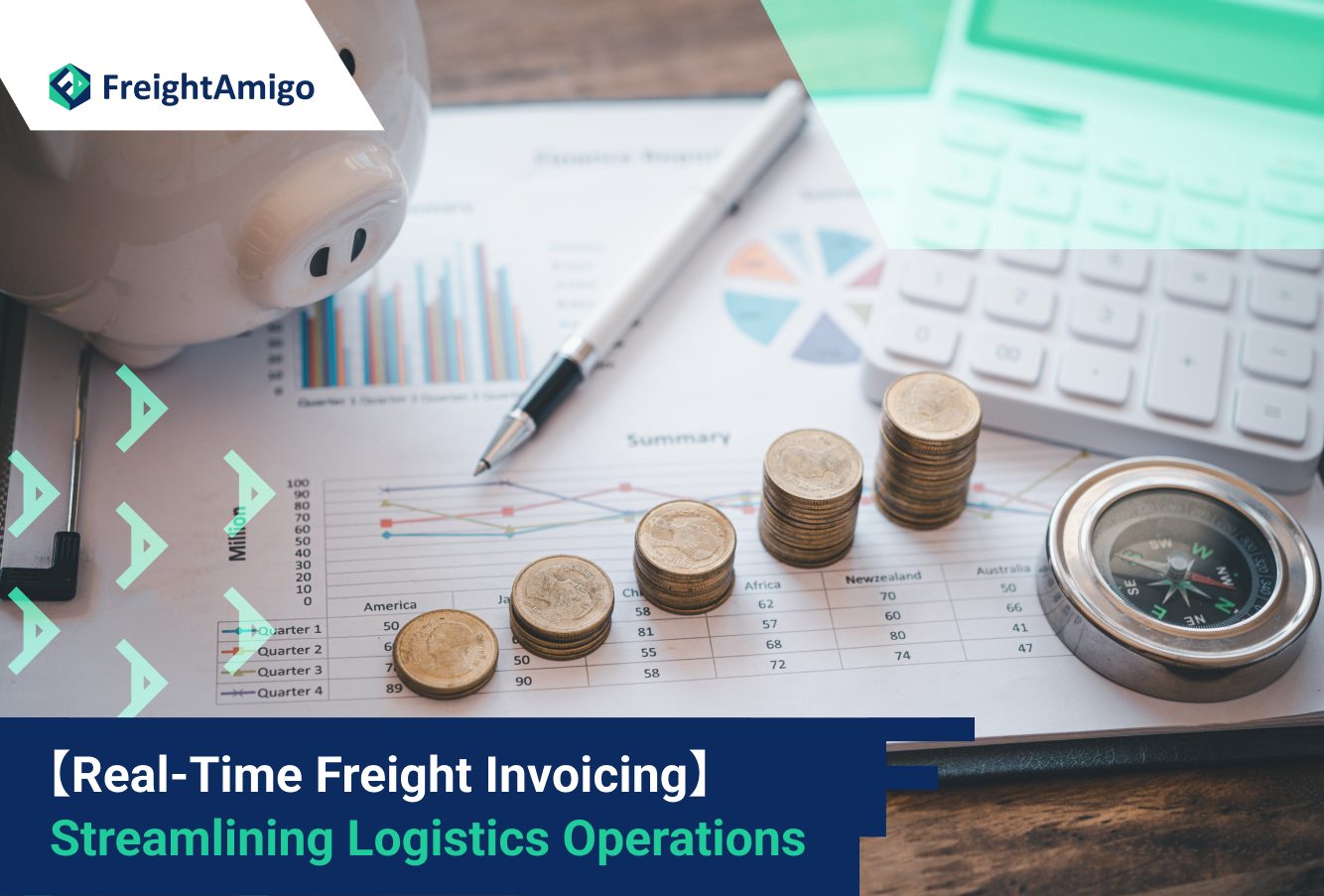January 5th, 2024: Maya Wong – Marketing Analyst at FreightAmigo
In the fast-paced world of logistics and transportation, efficiency and accuracy are paramount. Manual invoice processing can be a time-consuming and error-prone task, leading to delays in payment processing, strained supplier relationships, and increased operational costs. However, with the advent of real-time freight invoicing systems, businesses can streamline their operations, improve cash flow management, and enhance customer satisfaction. In this article, we will explore the benefits and challenges of implementing real-time freight invoicing systems, and how they can revolutionize the logistics industry.
Want To Compare The Best Express, Air Freight, Sea Freight, Rail Freight & Trucking Rates So As To Have Better Control On Cost?
The Significance of Real-Time Freight Invoicing
Real-time freight invoicing systems enable businesses to process invoices instantly, providing them with up-to-date information on their financials and improving overall operational efficiency. These systems utilize advanced technologies such as automation, machine learning, and data analytics to capture, process, and manage invoices in real-time. By eliminating manual data entry and automating workflows, businesses can reduce errors, save time, and focus on more strategic tasks.
Faster Processing Times and Improved Cash Flow
One of the primary advantages of real-time freight invoicing is the significant reduction in processing times. Manual invoice processing can be a labor-intensive and time-consuming process, requiring employees to manually enter data, validate invoices, and process payments. With real-time invoicing systems, this entire process can be streamlined, allowing businesses to generate and process invoices at lightning speed. This not only improves operational efficiency but also accelerates the payment cycle, enabling businesses to better manage their cash flow.
Enhanced Accuracy and Reduced Errors
Manual invoice processing is prone to errors, such as incorrect data entry, duplicate entries, and mismatches. These errors can result in delayed payments, disputes with suppliers, and financial discrepancies. Real-time freight invoicing systems leverage automation and data validation techniques to minimize errors and ensure accuracy. By automating data entry and validation processes, businesses can eliminate human error, reduce the risk of discrepancies, and improve overall data accuracy.
Increased Visibility and Control
Real-time freight invoicing systems provide businesses with real-time visibility into their invoice lifecycle. From the moment an invoice is received to its final payment, businesses can track and monitor its progress, enabling them to take immediate action on any exceptions or issues that may arise. This visibility and control empower businesses to proactively manage their finances, identify bottlenecks in the invoicing process, and make informed decisions based on up-to-date information.
Streamlined Approval Workflows
Approval workflows in manual invoice processing can be complex and time-consuming, involving multiple stakeholders and manual routing of invoices. Real-time freight invoicing systems automate approval workflows, enabling businesses to define and enforce predefined rules and hierarchies. This streamlines the approval process, reduces approval cycle times, and ensures timely payments. Additionally, automated systems provide stakeholders with real-time notifications and alerts, improving communication and collaboration between departments.
Cost Savings and Operational Efficiency
Implementing a real-time freight invoicing system can result in significant cost savings and operational efficiency improvements. By reducing manual data entry, automating workflows, and improving accuracy, businesses can save time and resources previously spent on manual invoice processing. These savings can be redirected to more value-added tasks, such as strategic planning, customer service, and business growth initiatives. Additionally, real-time invoicing systems help identify discrepancies, overages, and undercharges, allowing businesses to optimize costs and negotiate better terms with suppliers.
Challenges of Implementing Real-Time Freight Invoicing Systems
While real-time freight invoicing systems offer numerous benefits, businesses may encounter challenges during the implementation process. It is crucial to address these challenges proactively to ensure a successful transition.
Initial Investment and Integration Complexity
Implementing a real-time freight invoicing system requires an initial investment in technology, software, and infrastructure. This investment may pose financial challenges for smaller businesses with limited budgets. Additionally, integrating the new system with existing systems and processes can be complex, requiring careful planning, compatibility assessments, and potential system upgrades. However, the long-term benefits of efficiency, cost savings, and improved customer satisfaction often outweigh the initial investment.
Change Management and Employee Adoption
Introducing a real-time freight invoicing system may face resistance from employees who are accustomed to manual processes. Change management efforts should focus on clearly communicating the benefits of the new system, addressing any concerns or misconceptions, and providing comprehensive training to employees. By involving employees in the transition process, businesses can foster acceptance and adoption of the new system, ensuring a smooth implementation.
Supplier Onboarding and Compliance
Implementing a real-time freight invoicing system requires collaboration with suppliers to ensure smooth onboarding and compliance. Suppliers may need to adapt to new invoicing standards or formats, which can pose challenges for those who are not technologically equipped or resistant to change. Clear communication, training, and support should be provided to suppliers to facilitate their transition to the new system. Collaboration with suppliers strengthens relationships, improves invoicing accuracy, and enhances overall operational efficiency.
Regulatory and Compliance Risks
While automation systems can improve compliance through validation rules and real-time monitoring, changes in regulations or legal requirements may necessitate updates to the automated system. Businesses should stay informed about evolving regulations and ensure ongoing compliance to mitigate regulatory risks. Regular audits and data security measures should be implemented to protect sensitive financial information and maintain compliance with industry standards.
System Dependence and Downtime Risks
Relying heavily on automation systems can create a dependency on technology. In the event of system failures, technical glitches, or downtime, there could be delays or interruptions in invoice processing, potentially impacting operations and supplier relationships. Businesses should have contingency plans in place and regularly back up data to minimize the impact of system downtime.
The Future of Real-Time Freight Invoicing
The future of real-time freight invoicing is promising, with ongoing advancements in technology and automation. Emerging technologies such as blockchain and artificial intelligence are being explored to further enhance the efficiency and security of invoice processing. These technologies offer the potential for improved transparency, traceability, and fraud prevention in the invoicing process.
Additionally, the integration of real-time freight invoicing systems with other logistics and supply chain management technologies is expected to revolutionize the industry. By connecting real-time invoicing data with inventory management systems, transportation management systems, and customer relationship management platforms, businesses can achieve end-to-end visibility, optimize supply chain operations, and provide enhanced customer experiences.
As the logistics industry continues to evolve, real-time freight invoicing will become an essential component of efficient and customer-centric operations. Businesses that embrace automation, leverage advanced technologies, and prioritize continuous improvement in their invoicing processes will gain a competitive edge, enhance customer satisfaction, and drive growth in the global marketplace.
Conclusion
In conclusion, real-time freight invoicing systems offer significant advantages in streamlining logistics operations. By enabling faster processing times, enhancing accuracy, increasing visibility and control, streamlining approval workflows, and achieving cost savings, these systems revolutionize the way businesses manage their invoices. While there may be challenges during implementation, addressing them proactively and ensuring effective change management can lead to a successful transition. As the future of real-time freight invoicing unfolds, businesses that embrace automation and leverage advanced technologies will position themselves as leaders in the logistics industry.
There Are Different Options For Cargo Transportation. If You Want To Choose The Most Convenient And Suitable Solution, It Is Best To Have The Full Support Of Logistics Experts! If You Are Planning To Ship Goods Overseas, Please Go To The FreightAmigo Page For Inquiries.
===
Read More:
【Import and Export Insights for 2024】 Exploring New Opportunities in Emerging Markets
【Ecommerce Forecast 2024】 A Global Perspective
===
If you have any inquiries on logistics/supply chain, feel free to contact FreightAmigo now:
Chat with us online OR
Phone : +852 28121686
WhatsApp: +852 27467829









































